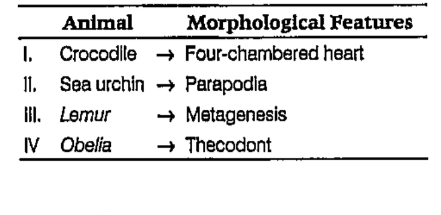Which of the following is correctly matched ?
Parthenium hyserophorus - Threat to biodiversity
Stratification - Population
Aerenchyma - Opuntia
Age pyramid - Biome
The correct Answer is:A
To determine which of the following options is correctly matched, we will analyze each option one by one.
1. Analyzing Option 1: Pythenium hystrophorus and its relation to biodiversity
- Pythenium hystrophorus is known to be a toxic plant that affects farm animals and can cause allergic reactions in humans.
- It is considered an invasive species, which can significantly impact biodiversity.
- Therefore, this option is correctly matched with "3-8 for biodiversity."
2. Analyzing Option 2: Stratification and Population
- Stratification refers to the layering or arrangement of different levels within an ecosystem, typically concerning vegetation or habitats.
- It is not directly related to population dynamics but rather to ecological structure.
- Hence, this option is incorrectly matched.
3. Analyzing Option 3: Erenkaima and Aponchia
- Erenkaima is a type of tissue found in hydrophytes (aquatic plants).
- Aponchia, on the other hand, is typically found in desert environments.
- Since these two are from different ecological contexts, this option is also incorrectly matched.
4. Analyzing Option 4: Age Pyramid and Bio
- An age pyramid is a graphical representation of the distribution of various age groups in a population.
- It is not specifically matched with "bio" but rather illustrates population distribution.
- Therefore, this option is incorrectly matched as well.
Conclusion:
After analyzing all options, we conclude that Option 1: Pythenium hystrophorus and its relation to biodiversity is the only correctly matched pair.
---
- Pythenium hystrophorus is known to be a toxic plant that affects farm animals and can cause allergic reactions in humans.
- It is considered an invasive species, which can significantly impact biodiversity.
- Therefore, this option is correctly matched with "3-8 for biodiversity."
- Stratification refers to the layering or arrangement of different levels within an ecosystem, typically concerning vegetation or habitats.
- It is not directly related to population dynamics but rather to ecological structure.
- Hence, this option is incorrectly matched.
- Erenkaima is a type of tissue found in hydrophytes (aquatic plants).
- Aponchia, on the other hand, is typically found in desert environments.
- Since these two are from different ecological contexts, this option is also incorrectly matched.
- An age pyramid is a graphical representation of the distribution of various age groups in a population.
- It is not specifically matched with "bio" but rather illustrates population distribution.
- Therefore, this option is incorrectly matched as well.
After analyzing all options, we conclude that Option 1: Pythenium hystrophorus and its relation to biodiversity is the only correctly matched pair.
Topper's Solved these Questions
- BOOK - PHYSICS WALLAHCHAPTER - BIODIVERSITY AND CONSERVATIONEXERCISE - LEVEL-230videos
BIODIVERSITY AND CONSERVATION
- BOOK - PHYSICS WALLAHCHAPTER - ANIMAL KINGDOMEXERCISE - NEET PAST 10 YEARS QUESTIONS45videos
ANIMAL KINGDOM
- BOOK - PHYSICS WALLAHCHAPTER - BIOLOGICAL CLASSIFICATIONEXERCISE - NEET Past 10 Years Questions52videos
BIOLOGICAL CLASSIFICATION
Similar Questions
Knowledge Check
- Question 1 - Select One or More
Which of the following are correctly matched ?
AButter-gelBMilk-emulsionCFor-aerosolDDust-Solid sol - Question 2 - Select One
Which of the following are correctly matched?
ASchweitzer's reagent →An ammoniacal solution of cupric sulphateBBordeaus mixture →CuSO4 and Ca(OH)2CSemiconductor →GeDHorn silver →AgNO3 - Question 3 - Select One
Which of the following are correctly matched ?
 AI,III and IVBII , III and IVCI and IVDonly I
AI,III and IVBII , III and IVCI and IVDonly I

